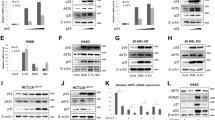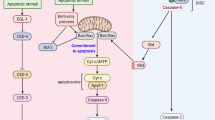Abstract
The p53-induced protein with a death domain, PIDD, was identified as a p53 target gene whose main role is to execute apoptosis in a p53-dependent manner. To investigate the physiological role of PIDD in apoptosis, we generated PIDD-deficient mice. Here, we report that, although PIDD expression is inducible upon DNA damage, PIDD-deficient mice undergo apoptosis normally not only in response to DNA damage, but also in response to various p53-independent stress signals and to death receptor (DR) engagement. This indicates that PIDD is not required for DNA damage-, stress-, and DR-induced apoptosis. Also, in the absence of PIDD, both caspase-2 processing and activation occur in response to DNA damage. Our findings demonstrate that PIDD does not play an essential role for all p53-mediated or p53-independent apoptotic pathways.





Similar content being viewed by others
References
Adams JM (2003) Ways of dying: multiple pathways to apoptosis. Genes Dev 17:2481–2495
Locksley RM, Killeen N, Lenardo MJ (2001) The TNF and TNF receptor superfamilies: integrating mammalian biology. Cell 104:487–501
Schutze S, Tchikov V, Schneider-Brachert W (2008) Regulation of TNFR1 and CD95 signalling by receptor compartmentalization. Nat Rev Mol Cell Biol 9:655–662
Ashkenazi A (2002) Targeting death and decoy receptors of the tumour-necrosis factor superfamily. Nat Rev Cancer 2:420–430
Fisher GH, Rosenberg FJ, Straus SE et al (1995) Dominant interfering Fas gene mutations impair apoptosis in a human autoimmune lymphoproliferative syndrome. Cell 81:935–946
Rieux-Laucat F, Le Deist F, Hivroz C et al (1995) Mutations in Fas associated with human lymphoproliferative syndrome and autoimmunity. Science 268:1347–1349
Bidere N, Su HC, Lenardo MJ (2006) Genetic disorders of programmed cell death in the immune system. Annu Rev Immunol 24:321–352
Vousden KH, Lane DP (2007) p53 in health and disease. Nat Rev Mol Cell Biol 8:275–283
Ko LJ, Prives C (1996) p53: puzzle and paradigm. Genes Dev 10:1054–1072
Vogelstein B, Lane D, Levine AJ (2000) Surfing the p53 network. Nature 408:307–310
Kern SE, Kinzler KW, Bruskin A et al (1991) Identification of p53 as a sequence-specific DNA-binding protein. Science 252:1708–1711
Lin Y, Ma W, Benchimol S (2000) Pidd, a new death-domain-containing protein, is induced by p53 and promotes apoptosis. Nat Genet 26:122–127
Tinel A, Janssens S, Lippens S et al (2007) Autoproteolysis of PIDD marks the bifurcation between pro-death caspase-2 and pro-survival NF-kappaB pathway. Embo J 26:197–208
Tinel A, Tschopp J (2004) The PIDDosome, a protein complex implicated in activation of caspase-2 in response to genotoxic stress. Science 304:843–846
Berube C, Boucher LM, Ma W et al (2005) Apoptosis caused by p53-induced protein with death domain (PIDD) depends on the death adapter protein RAIDD. Proc Natl Acad Sci USA 102:14314–14320
O’Reilly LA, Ekert P, Harvey N et al (2002) Caspase-2 is not required for thymocyte or neuronal apoptosis even though cleavage of caspase-2 is dependent on both Apaf-1 and caspase-9. Cell Death Differ 9:832–841
Park HH, Logette E, Raunser S et al (2007) Death domain assembly mechanism revealed by crystal structure of the oligomeric PIDDosome core complex. Cell 128:533–546
Ho LH, Read SH, Dorstyn L, Lambrusco L, Kumar S (2008) Caspase-2 is required for cell death induced by cytoskeletal disruption. Oncogene 27:3393–3404
Perez GI, Tao XJ, Tilly JL (1999) Fragmentation and death (a.k.a. apoptosis) of ovulated oocytes. Mol Hum Reprod 5:414–420
Jurisicova A, Lee HJ, D’Estaing SG, Tilly J, Perez GI (2006) Molecular requirements for doxorubicin-mediated death in murine oocytes. Cell Death Differ 13:1466–1474
Bergeron L, Perez GI, Macdonald G et al (1998) Defects in regulation of apoptosis in caspase-2-deficient mice. Genes Dev 12:1304–1314
Shi M, Vivian CJ, Lee KJ et al (2009) DNA-PKcs-PIDDosome: a nuclear caspase-2-activating complex with role in G2/M checkpoint maintenance. Cell 136:508–520
Olsson M, Vakifahmetoglu H, Abruzzo PM, Hogstrand K, Grandien A, Zhivotovsky B (2009) DISC-mediated activation of caspase-2 in DNA damage-induced apoptosis. Oncogene 28:1949–1959
Manzl C, Krumschnabel G, Bock F et al (2009) Caspase-2 activation in the absence of PIDDosome formation. J Cell Biol 185:291–303
Lamkanfi M, Declercq W, Kalai M, Saelens X, Vandenabeele P (2002) Alice in caspase land. A phylogenetic analysis of caspases from worm to man. Cell Death Differ 9:358–361
Takai Y, Canning J, Perez GI et al (2003) Bax, caspase-2, and caspase-3 are required for ovarian follicle loss caused by 4-vinylcyclohexene diepoxide exposure of female mice in vivo. Endocrinology 144:69–74
Troy CM, Stefanis L, Greene LA, Shelanski ML (1997) Nedd2 is required for apoptosis after trophic factor withdrawal, but not superoxide dismutase (SOD1) downregulation, in sympathetic neurons and PC12 cells. J Neurosci 17:1911–1918
Cuenin S, Tinel A, Janssens S, Tschopp J (2008) p53-induced protein with a death domain (PIDD) isoforms differentially activate nuclear factor-kappaB and caspase-2 in response to genotoxic stress. Oncogene 27:387–396
Janssens S, Tinel A, Lippens S, Tschopp J (2005) PIDD mediates NF-kappaB activation in response to DNA damage. Cell 123:1079–1092
Nutt LK, Margolis SS, Jensen M et al (2005) Metabolic regulation of oocyte cell death through the CaMKII-mediated phosphorylation of caspase-2. Cell 123:89–103
Jones RG, Plas DR, Kubek S et al (2005) AMP-activated protein kinase induces a p53-dependent metabolic checkpoint. Mol Cell 18:283–293
Acknowledgments
We are grateful to D. Wakeham, A. Etoh You-Ten, and A. Elia for technical assistance; Linh Nguyen for critical reading of this manuscript. This study was supported by operating grants for P·S.O. and W·C.Y. from the Canadian Institute of Health Research and the NCIC with funds from the Canadian Cancer Society. We also thank the PRP department at Toronto General Hospital for their expertise on histological staining.
Conflict of interest
The authors declare no financial or commercial conflict of interest.
Author information
Authors and Affiliations
Corresponding author
Electronic supplementary material
Below is the link to the electronic supplementary material.
Rights and permissions
About this article
Cite this article
Kim, I.R., Murakami, K., Chen, NJ. et al. DNA damage- and stress-induced apoptosis occurs independently of PIDD. Apoptosis 14, 1039–1049 (2009). https://doi.org/10.1007/s10495-009-0375-1
Published:
Issue Date:
DOI: https://doi.org/10.1007/s10495-009-0375-1




